TOUR OPERATIONS MANAGEMENT
VerifiedAdded on 2024/04/26
|22
|4065
|356
AI Summary
Explore the recent trends in the tour operating industry, stages involved in developing holidays, suitability of different contracting methods, pricing strategies, brochure design planning, and strategic decision-making processes. Understand the impact of globalization, digital technology, and customer satisfaction on tour operations.
Contribute Materials
Your contribution can guide someone’s learning journey. Share your
documents today.
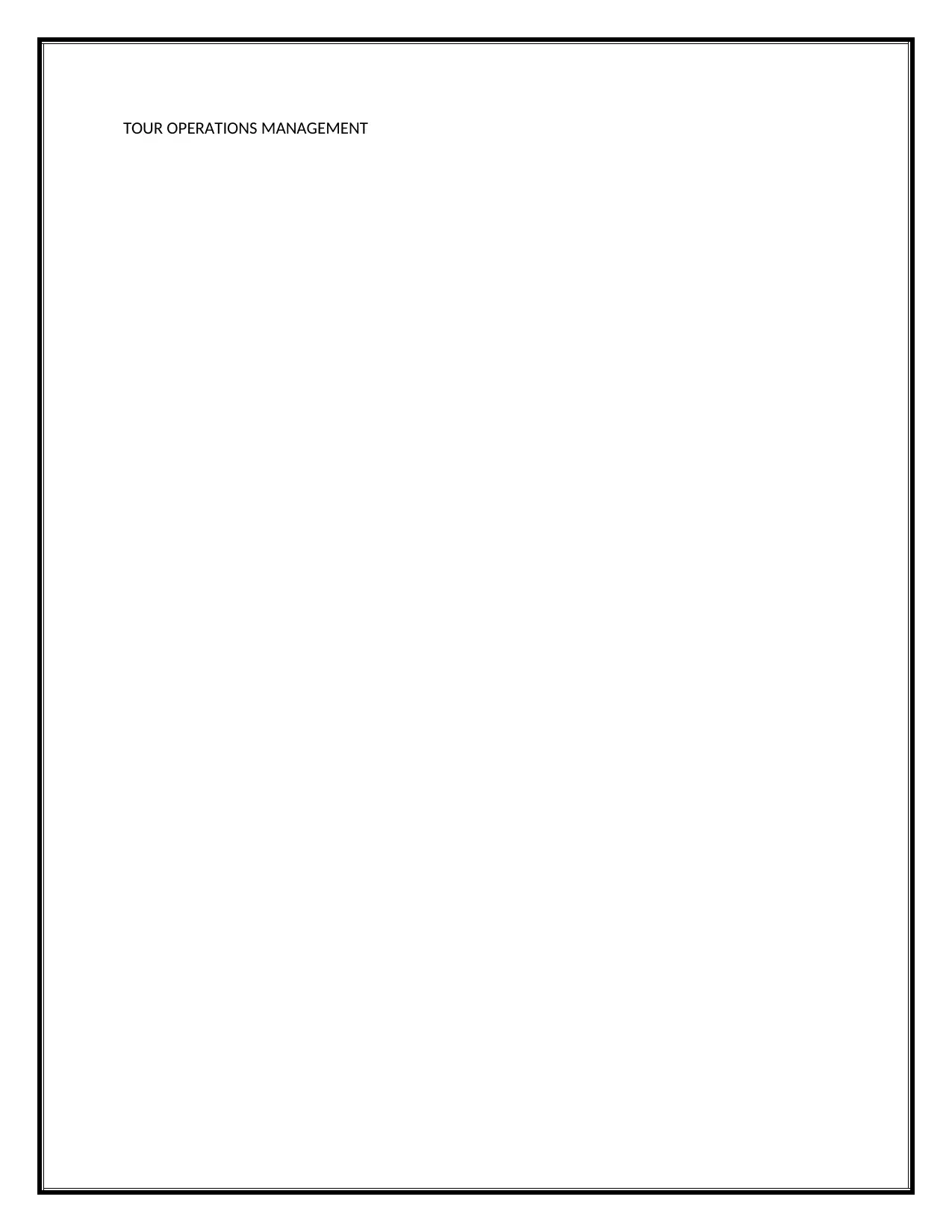
TOUR OPERATIONS MANAGEMENT
Secure Best Marks with AI Grader
Need help grading? Try our AI Grader for instant feedback on your assignments.

Contents
INTRODUCTION................................................................................................................................2
1.1 RECENT TRENDS IN TOUR OPERATING INDUSTRY...............................................................3
2.1 STAGES AND TIMESCALES INVOLVED IN DEVELOPING HOLIDAYS............................................5
2.2 SUITABILITY OF DIFFERENT METHODS OF CONTRACTING FOR DIFFERENT COMPONENTS OF
THE HOLIDAY AND DIFFERENT TYPES OF TOUR OPERATORS..........................................................6
2.3 SELLING PRICE OF HOLIDAY.......................................................................................................9
3.1 BROCHURE DESIGN PLANNING...............................................................................................10
3.2 SUITABILITY OF ALTERNATIVES TO A TRADITIONAL BROCHURE.............................................12
3.3 SUITABILITY OF DIFFERENT METHODS OF DISTRIBUTION USED TO SELL A HOLIDAY.............13
4.1 STRATEGIC DECISION MAKING................................................................................................15
4.2 TACTIC DECISIONS MAKING PROCESS.....................................................................................16
CONCLUSION.................................................................................................................................17
REFERENCES...................................................................................................................................18
INTRODUCTION................................................................................................................................2
1.1 RECENT TRENDS IN TOUR OPERATING INDUSTRY...............................................................3
2.1 STAGES AND TIMESCALES INVOLVED IN DEVELOPING HOLIDAYS............................................5
2.2 SUITABILITY OF DIFFERENT METHODS OF CONTRACTING FOR DIFFERENT COMPONENTS OF
THE HOLIDAY AND DIFFERENT TYPES OF TOUR OPERATORS..........................................................6
2.3 SELLING PRICE OF HOLIDAY.......................................................................................................9
3.1 BROCHURE DESIGN PLANNING...............................................................................................10
3.2 SUITABILITY OF ALTERNATIVES TO A TRADITIONAL BROCHURE.............................................12
3.3 SUITABILITY OF DIFFERENT METHODS OF DISTRIBUTION USED TO SELL A HOLIDAY.............13
4.1 STRATEGIC DECISION MAKING................................................................................................15
4.2 TACTIC DECISIONS MAKING PROCESS.....................................................................................16
CONCLUSION.................................................................................................................................17
REFERENCES...................................................................................................................................18
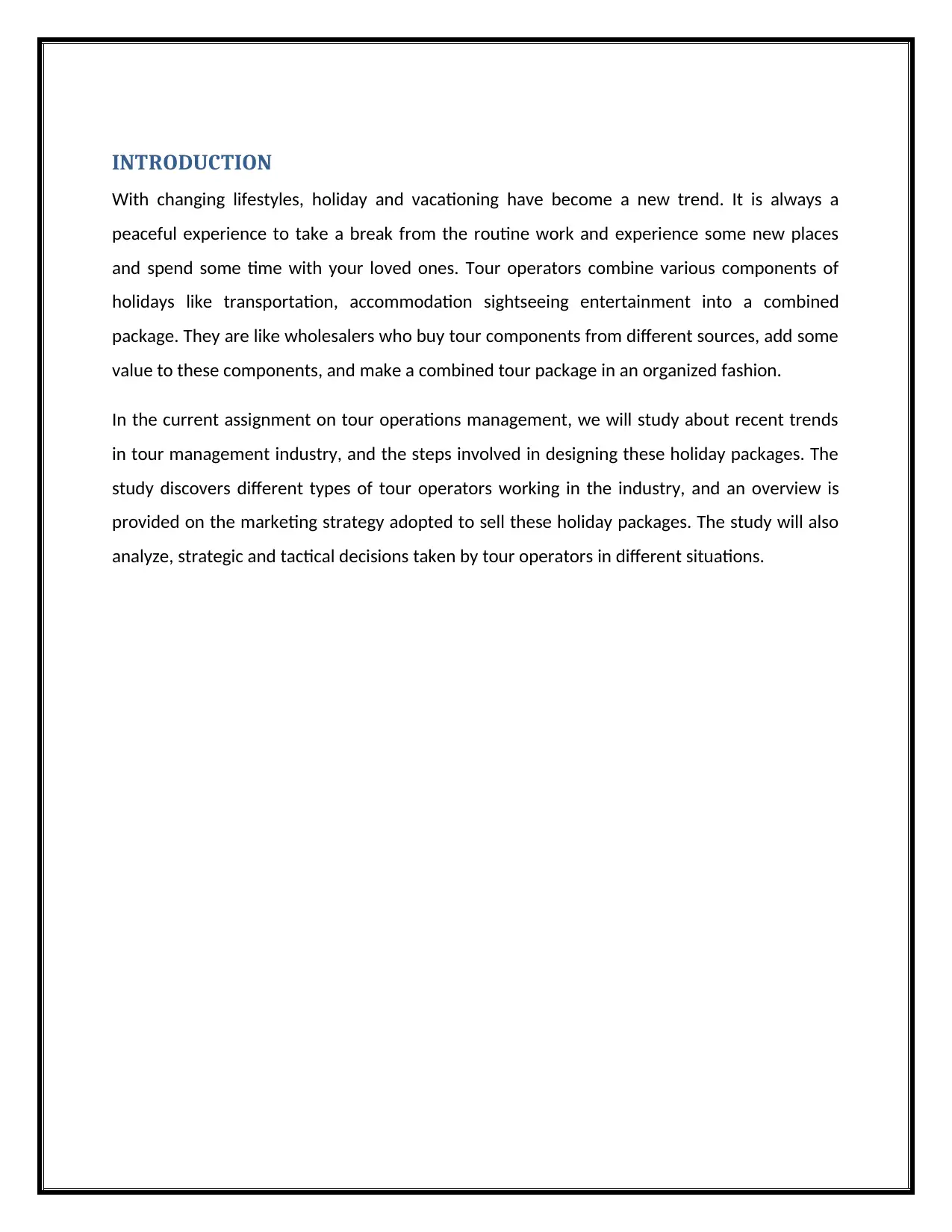
INTRODUCTION
With changing lifestyles, holiday and vacationing have become a new trend. It is always a
peaceful experience to take a break from the routine work and experience some new places
and spend some time with your loved ones. Tour operators combine various components of
holidays like transportation, accommodation sightseeing entertainment into a combined
package. They are like wholesalers who buy tour components from different sources, add some
value to these components, and make a combined tour package in an organized fashion.
In the current assignment on tour operations management, we will study about recent trends
in tour management industry, and the steps involved in designing these holiday packages. The
study discovers different types of tour operators working in the industry, and an overview is
provided on the marketing strategy adopted to sell these holiday packages. The study will also
analyze, strategic and tactical decisions taken by tour operators in different situations.
With changing lifestyles, holiday and vacationing have become a new trend. It is always a
peaceful experience to take a break from the routine work and experience some new places
and spend some time with your loved ones. Tour operators combine various components of
holidays like transportation, accommodation sightseeing entertainment into a combined
package. They are like wholesalers who buy tour components from different sources, add some
value to these components, and make a combined tour package in an organized fashion.
In the current assignment on tour operations management, we will study about recent trends
in tour management industry, and the steps involved in designing these holiday packages. The
study discovers different types of tour operators working in the industry, and an overview is
provided on the marketing strategy adopted to sell these holiday packages. The study will also
analyze, strategic and tactical decisions taken by tour operators in different situations.

Figure 1: The Holidays
Source: [http://goahotelsdeals.com/]
Source: [http://goahotelsdeals.com/]
Secure Best Marks with AI Grader
Need help grading? Try our AI Grader for instant feedback on your assignments.
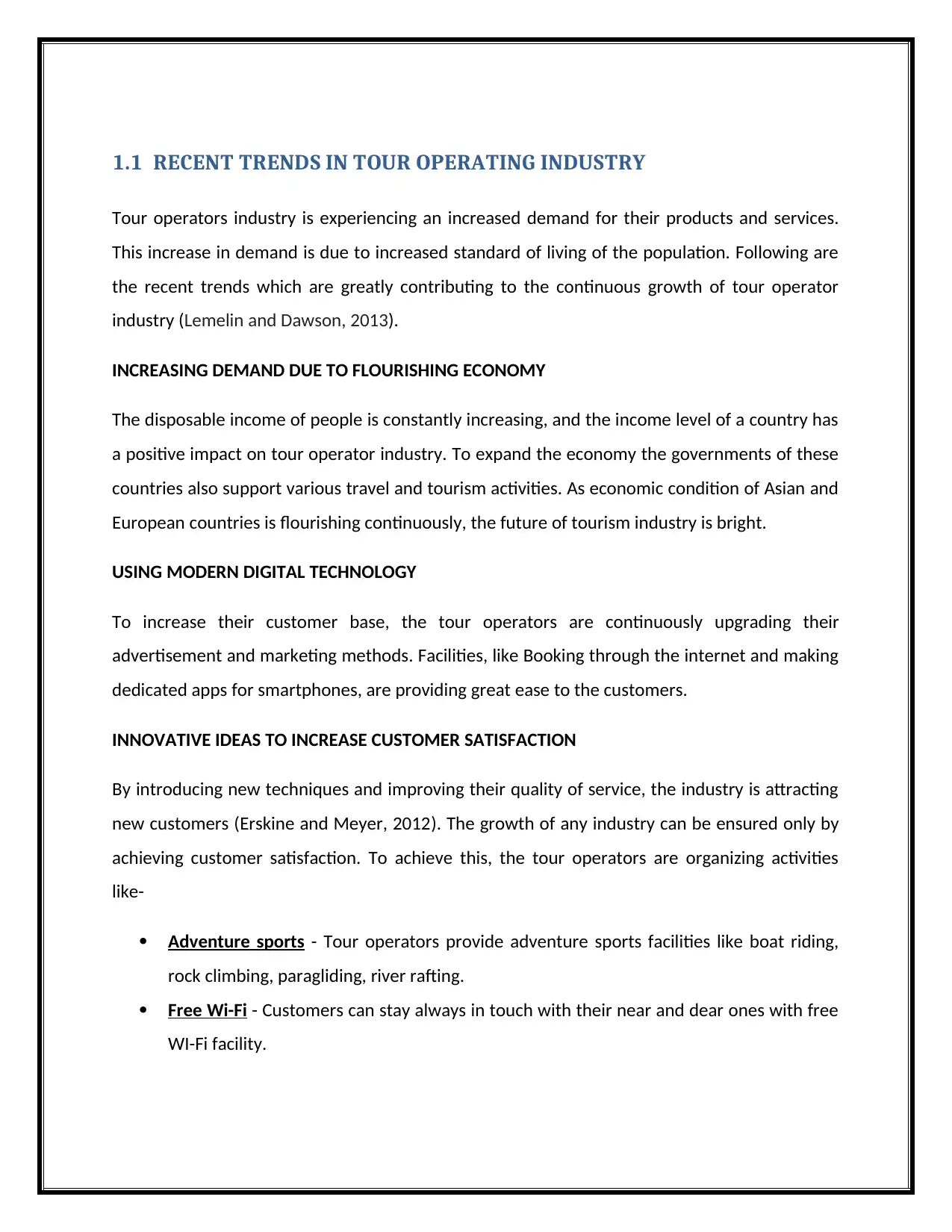
1.1 RECENT TRENDS IN TOUR OPERATING INDUSTRY
Tour operators industry is experiencing an increased demand for their products and services.
This increase in demand is due to increased standard of living of the population. Following are
the recent trends which are greatly contributing to the continuous growth of tour operator
industry (Lemelin and Dawson, 2013).
INCREASING DEMAND DUE TO FLOURISHING ECONOMY
The disposable income of people is constantly increasing, and the income level of a country has
a positive impact on tour operator industry. To expand the economy the governments of these
countries also support various travel and tourism activities. As economic condition of Asian and
European countries is flourishing continuously, the future of tourism industry is bright.
USING MODERN DIGITAL TECHNOLOGY
To increase their customer base, the tour operators are continuously upgrading their
advertisement and marketing methods. Facilities, like Booking through the internet and making
dedicated apps for smartphones, are providing great ease to the customers.
INNOVATIVE IDEAS TO INCREASE CUSTOMER SATISFACTION
By introducing new techniques and improving their quality of service, the industry is attracting
new customers (Erskine and Meyer, 2012). The growth of any industry can be ensured only by
achieving customer satisfaction. To achieve this, the tour operators are organizing activities
like-
Adventure sports - Tour operators provide adventure sports facilities like boat riding,
rock climbing, paragliding, river rafting.
Free Wi-Fi - Customers can stay always in touch with their near and dear ones with free
WI-Fi facility.
Tour operators industry is experiencing an increased demand for their products and services.
This increase in demand is due to increased standard of living of the population. Following are
the recent trends which are greatly contributing to the continuous growth of tour operator
industry (Lemelin and Dawson, 2013).
INCREASING DEMAND DUE TO FLOURISHING ECONOMY
The disposable income of people is constantly increasing, and the income level of a country has
a positive impact on tour operator industry. To expand the economy the governments of these
countries also support various travel and tourism activities. As economic condition of Asian and
European countries is flourishing continuously, the future of tourism industry is bright.
USING MODERN DIGITAL TECHNOLOGY
To increase their customer base, the tour operators are continuously upgrading their
advertisement and marketing methods. Facilities, like Booking through the internet and making
dedicated apps for smartphones, are providing great ease to the customers.
INNOVATIVE IDEAS TO INCREASE CUSTOMER SATISFACTION
By introducing new techniques and improving their quality of service, the industry is attracting
new customers (Erskine and Meyer, 2012). The growth of any industry can be ensured only by
achieving customer satisfaction. To achieve this, the tour operators are organizing activities
like-
Adventure sports - Tour operators provide adventure sports facilities like boat riding,
rock climbing, paragliding, river rafting.
Free Wi-Fi - Customers can stay always in touch with their near and dear ones with free
WI-Fi facility.
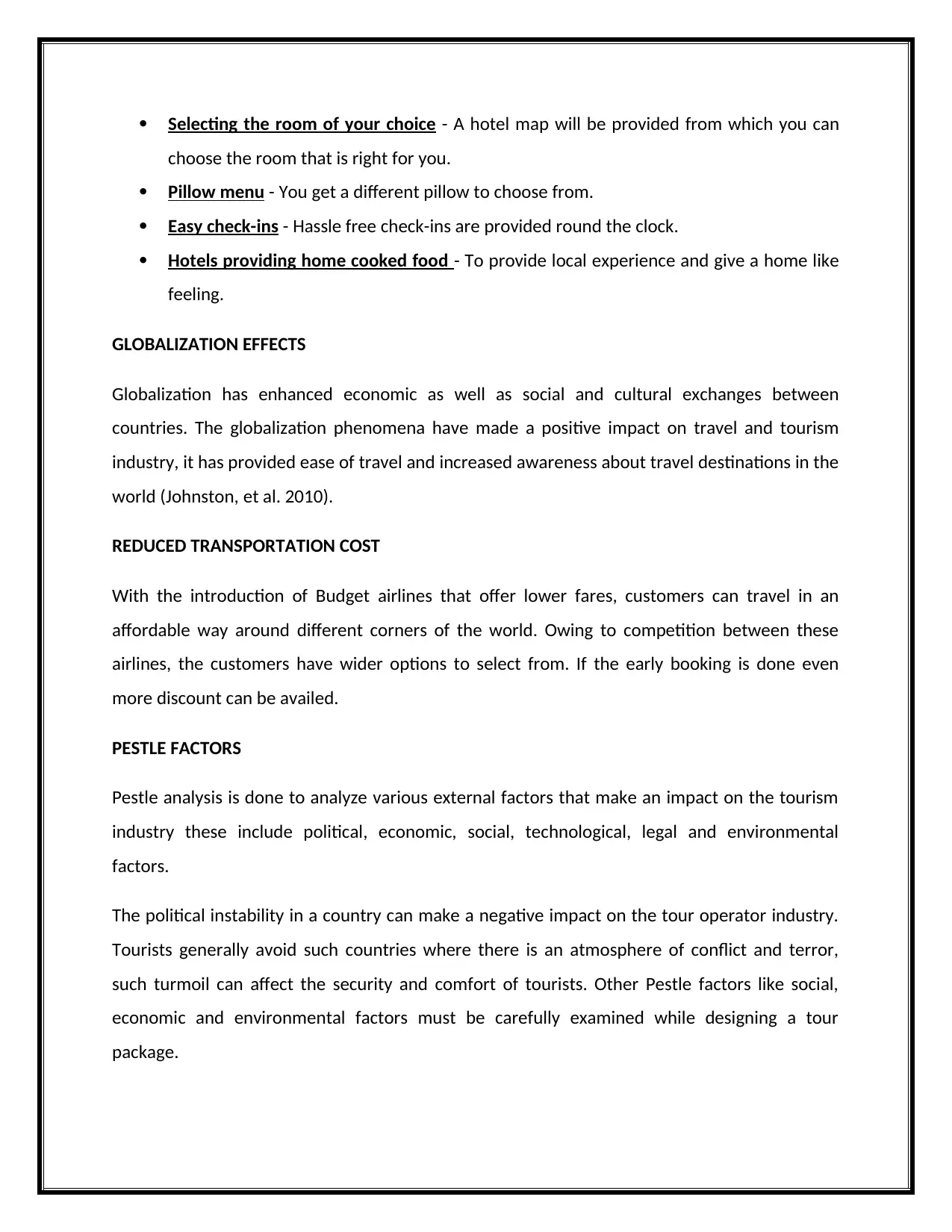
Selecting the room of your choice - A hotel map will be provided from which you can
choose the room that is right for you.
Pillow menu - You get a different pillow to choose from.
Easy check-ins - Hassle free check-ins are provided round the clock.
Hotels providing home cooked food - To provide local experience and give a home like
feeling.
GLOBALIZATION EFFECTS
Globalization has enhanced economic as well as social and cultural exchanges between
countries. The globalization phenomena have made a positive impact on travel and tourism
industry, it has provided ease of travel and increased awareness about travel destinations in the
world (Johnston, et al. 2010).
REDUCED TRANSPORTATION COST
With the introduction of Budget airlines that offer lower fares, customers can travel in an
affordable way around different corners of the world. Owing to competition between these
airlines, the customers have wider options to select from. If the early booking is done even
more discount can be availed.
PESTLE FACTORS
Pestle analysis is done to analyze various external factors that make an impact on the tourism
industry these include political, economic, social, technological, legal and environmental
factors.
The political instability in a country can make a negative impact on the tour operator industry.
Tourists generally avoid such countries where there is an atmosphere of conflict and terror,
such turmoil can affect the security and comfort of tourists. Other Pestle factors like social,
economic and environmental factors must be carefully examined while designing a tour
package.
choose the room that is right for you.
Pillow menu - You get a different pillow to choose from.
Easy check-ins - Hassle free check-ins are provided round the clock.
Hotels providing home cooked food - To provide local experience and give a home like
feeling.
GLOBALIZATION EFFECTS
Globalization has enhanced economic as well as social and cultural exchanges between
countries. The globalization phenomena have made a positive impact on travel and tourism
industry, it has provided ease of travel and increased awareness about travel destinations in the
world (Johnston, et al. 2010).
REDUCED TRANSPORTATION COST
With the introduction of Budget airlines that offer lower fares, customers can travel in an
affordable way around different corners of the world. Owing to competition between these
airlines, the customers have wider options to select from. If the early booking is done even
more discount can be availed.
PESTLE FACTORS
Pestle analysis is done to analyze various external factors that make an impact on the tourism
industry these include political, economic, social, technological, legal and environmental
factors.
The political instability in a country can make a negative impact on the tour operator industry.
Tourists generally avoid such countries where there is an atmosphere of conflict and terror,
such turmoil can affect the security and comfort of tourists. Other Pestle factors like social,
economic and environmental factors must be carefully examined while designing a tour
package.
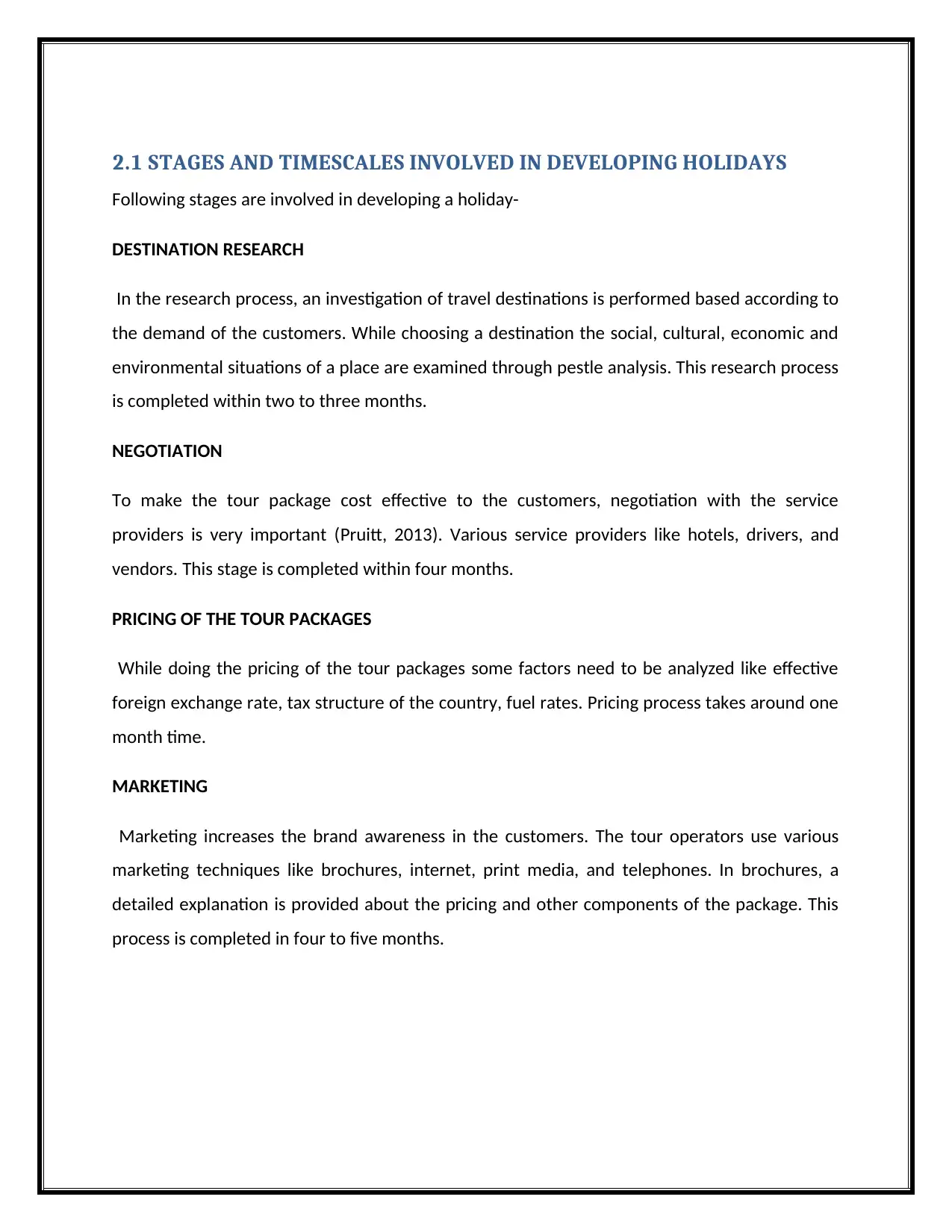
2.1 STAGES AND TIMESCALES INVOLVED IN DEVELOPING HOLIDAYS
Following stages are involved in developing a holiday-
DESTINATION RESEARCH
In the research process, an investigation of travel destinations is performed based according to
the demand of the customers. While choosing a destination the social, cultural, economic and
environmental situations of a place are examined through pestle analysis. This research process
is completed within two to three months.
NEGOTIATION
To make the tour package cost effective to the customers, negotiation with the service
providers is very important (Pruitt, 2013). Various service providers like hotels, drivers, and
vendors. This stage is completed within four months.
PRICING OF THE TOUR PACKAGES
While doing the pricing of the tour packages some factors need to be analyzed like effective
foreign exchange rate, tax structure of the country, fuel rates. Pricing process takes around one
month time.
MARKETING
Marketing increases the brand awareness in the customers. The tour operators use various
marketing techniques like brochures, internet, print media, and telephones. In brochures, a
detailed explanation is provided about the pricing and other components of the package. This
process is completed in four to five months.
Following stages are involved in developing a holiday-
DESTINATION RESEARCH
In the research process, an investigation of travel destinations is performed based according to
the demand of the customers. While choosing a destination the social, cultural, economic and
environmental situations of a place are examined through pestle analysis. This research process
is completed within two to three months.
NEGOTIATION
To make the tour package cost effective to the customers, negotiation with the service
providers is very important (Pruitt, 2013). Various service providers like hotels, drivers, and
vendors. This stage is completed within four months.
PRICING OF THE TOUR PACKAGES
While doing the pricing of the tour packages some factors need to be analyzed like effective
foreign exchange rate, tax structure of the country, fuel rates. Pricing process takes around one
month time.
MARKETING
Marketing increases the brand awareness in the customers. The tour operators use various
marketing techniques like brochures, internet, print media, and telephones. In brochures, a
detailed explanation is provided about the pricing and other components of the package. This
process is completed in four to five months.
Paraphrase This Document
Need a fresh take? Get an instant paraphrase of this document with our AI Paraphraser
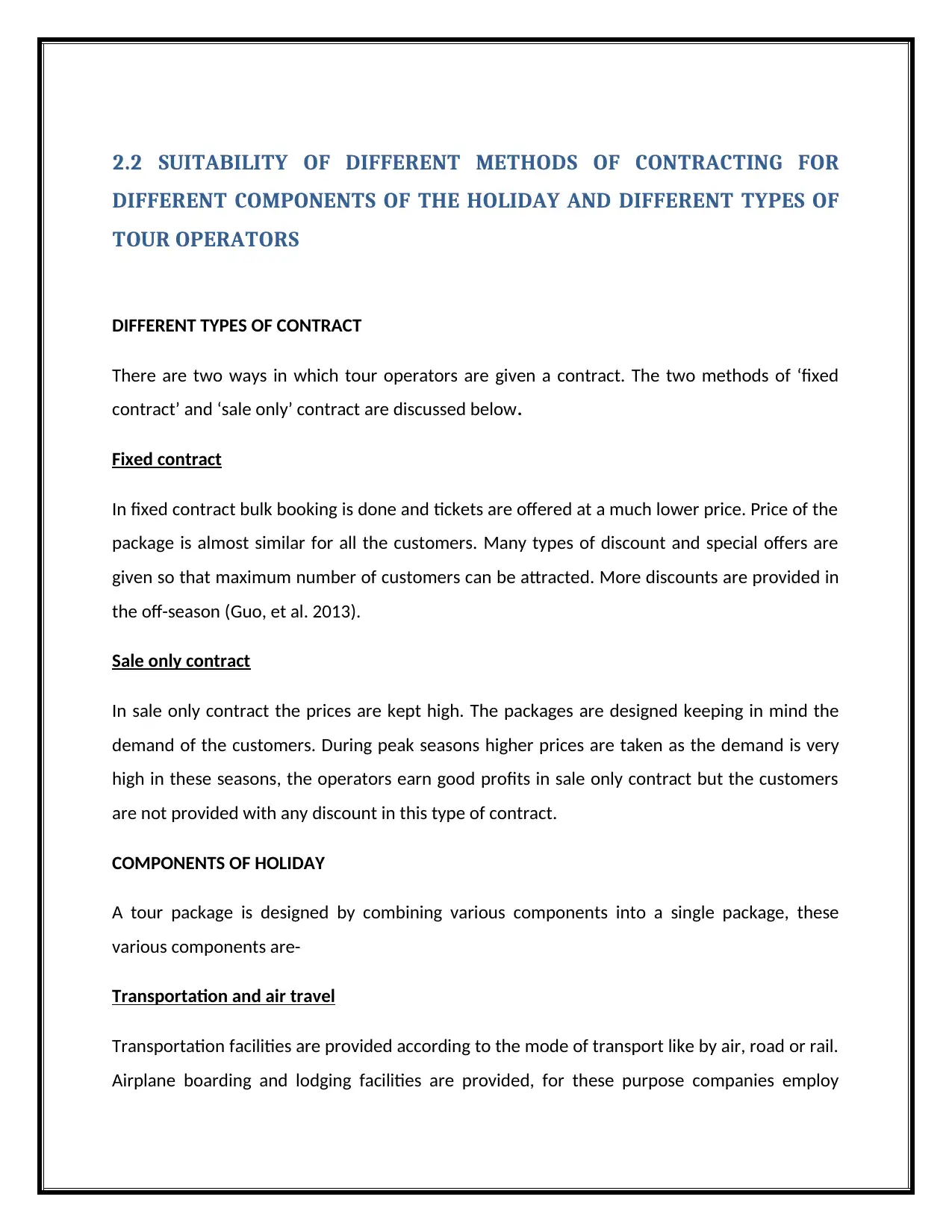
2.2 SUITABILITY OF DIFFERENT METHODS OF CONTRACTING FOR
DIFFERENT COMPONENTS OF THE HOLIDAY AND DIFFERENT TYPES OF
TOUR OPERATORS
DIFFERENT TYPES OF CONTRACT
There are two ways in which tour operators are given a contract. The two methods of ‘fixed
contract’ and ‘sale only’ contract are discussed below.
Fixed contract
In fixed contract bulk booking is done and tickets are offered at a much lower price. Price of the
package is almost similar for all the customers. Many types of discount and special offers are
given so that maximum number of customers can be attracted. More discounts are provided in
the off-season (Guo, et al. 2013).
Sale only contract
In sale only contract the prices are kept high. The packages are designed keeping in mind the
demand of the customers. During peak seasons higher prices are taken as the demand is very
high in these seasons, the operators earn good profits in sale only contract but the customers
are not provided with any discount in this type of contract.
COMPONENTS OF HOLIDAY
A tour package is designed by combining various components into a single package, these
various components are-
Transportation and air travel
Transportation facilities are provided according to the mode of transport like by air, road or rail.
Airplane boarding and lodging facilities are provided, for these purpose companies employ
DIFFERENT COMPONENTS OF THE HOLIDAY AND DIFFERENT TYPES OF
TOUR OPERATORS
DIFFERENT TYPES OF CONTRACT
There are two ways in which tour operators are given a contract. The two methods of ‘fixed
contract’ and ‘sale only’ contract are discussed below.
Fixed contract
In fixed contract bulk booking is done and tickets are offered at a much lower price. Price of the
package is almost similar for all the customers. Many types of discount and special offers are
given so that maximum number of customers can be attracted. More discounts are provided in
the off-season (Guo, et al. 2013).
Sale only contract
In sale only contract the prices are kept high. The packages are designed keeping in mind the
demand of the customers. During peak seasons higher prices are taken as the demand is very
high in these seasons, the operators earn good profits in sale only contract but the customers
are not provided with any discount in this type of contract.
COMPONENTS OF HOLIDAY
A tour package is designed by combining various components into a single package, these
various components are-
Transportation and air travel
Transportation facilities are provided according to the mode of transport like by air, road or rail.
Airplane boarding and lodging facilities are provided, for these purpose companies employ
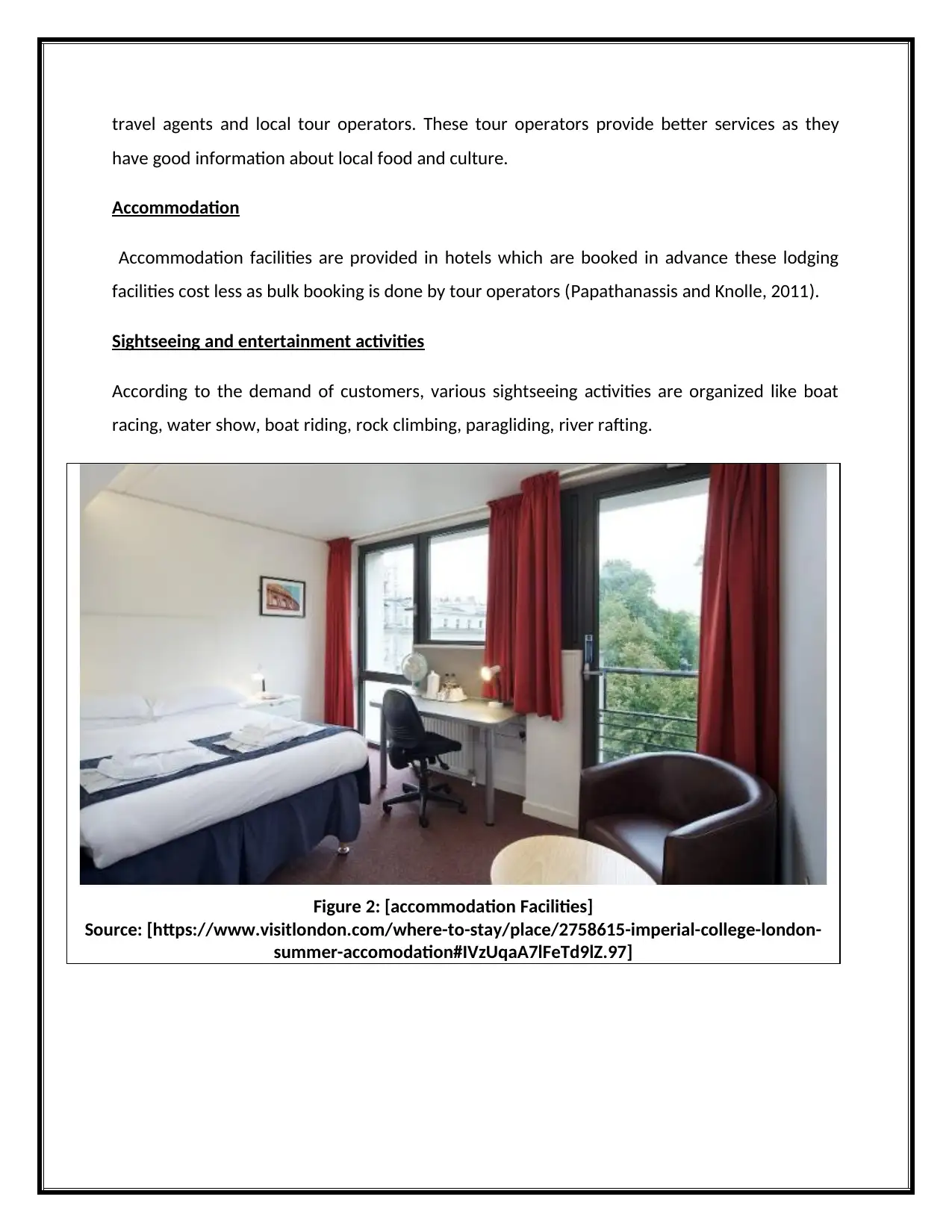
travel agents and local tour operators. These tour operators provide better services as they
have good information about local food and culture.
Accommodation
Accommodation facilities are provided in hotels which are booked in advance these lodging
facilities cost less as bulk booking is done by tour operators (Papathanassis and Knolle, 2011).
Sightseeing and entertainment activities
According to the demand of customers, various sightseeing activities are organized like boat
racing, water show, boat riding, rock climbing, paragliding, river rafting.
Figure 2: [accommodation Facilities]
Source: [https://www.visitlondon.com/where-to-stay/place/2758615-imperial-college-london-
summer-accomodation#IVzUqaA7lFeTd9lZ.97]
have good information about local food and culture.
Accommodation
Accommodation facilities are provided in hotels which are booked in advance these lodging
facilities cost less as bulk booking is done by tour operators (Papathanassis and Knolle, 2011).
Sightseeing and entertainment activities
According to the demand of customers, various sightseeing activities are organized like boat
racing, water show, boat riding, rock climbing, paragliding, river rafting.
Figure 2: [accommodation Facilities]
Source: [https://www.visitlondon.com/where-to-stay/place/2758615-imperial-college-london-
summer-accomodation#IVzUqaA7lFeTd9lZ.97]
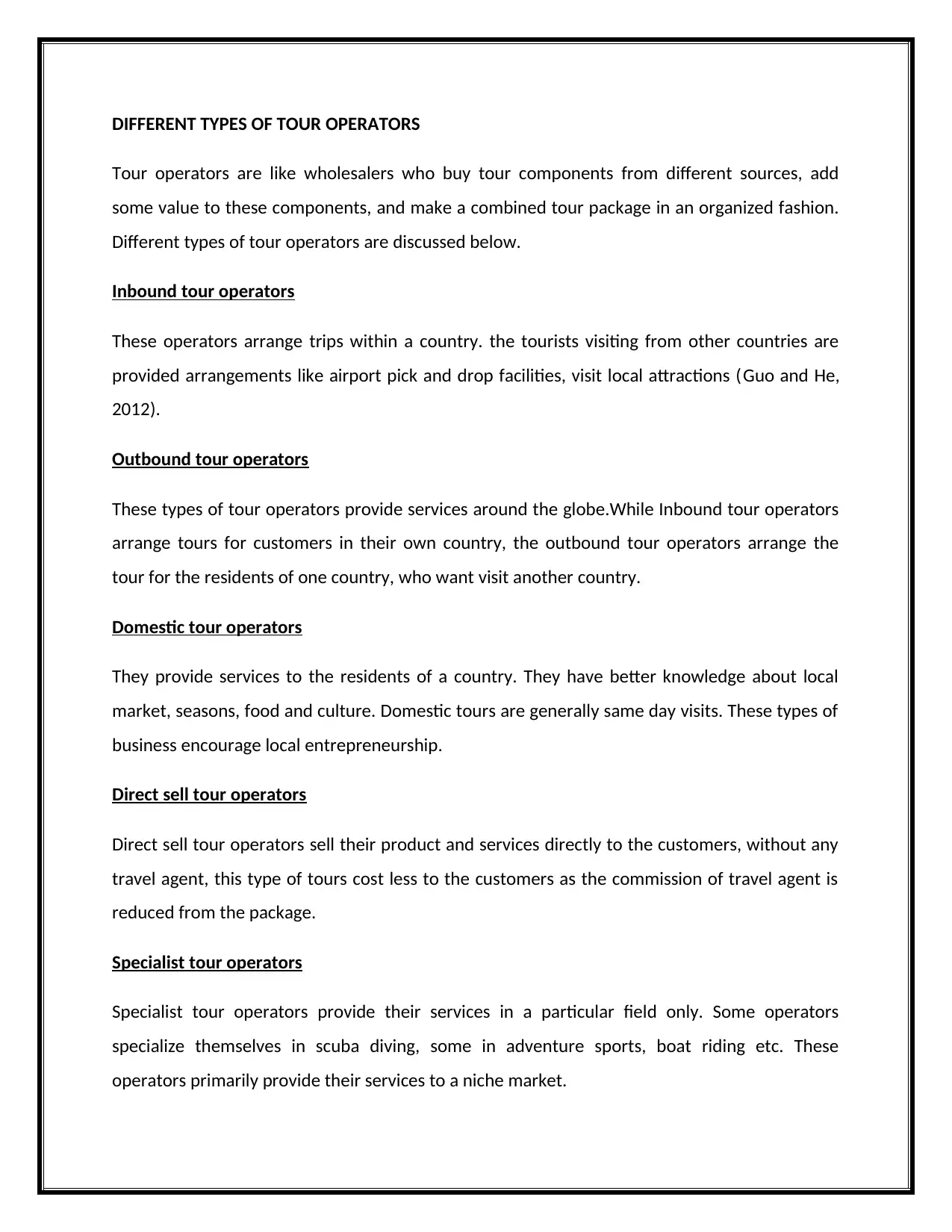
DIFFERENT TYPES OF TOUR OPERATORS
Tour operators are like wholesalers who buy tour components from different sources, add
some value to these components, and make a combined tour package in an organized fashion.
Different types of tour operators are discussed below.
Inbound tour operators
These operators arrange trips within a country. the tourists visiting from other countries are
provided arrangements like airport pick and drop facilities, visit local attractions (Guo and He,
2012).
Outbound tour operators
These types of tour operators provide services around the globe.While Inbound tour operators
arrange tours for customers in their own country, the outbound tour operators arrange the
tour for the residents of one country, who want visit another country.
Domestic tour operators
They provide services to the residents of a country. They have better knowledge about local
market, seasons, food and culture. Domestic tours are generally same day visits. These types of
business encourage local entrepreneurship.
Direct sell tour operators
Direct sell tour operators sell their product and services directly to the customers, without any
travel agent, this type of tours cost less to the customers as the commission of travel agent is
reduced from the package.
Specialist tour operators
Specialist tour operators provide their services in a particular field only. Some operators
specialize themselves in scuba diving, some in adventure sports, boat riding etc. These
operators primarily provide their services to a niche market.
Tour operators are like wholesalers who buy tour components from different sources, add
some value to these components, and make a combined tour package in an organized fashion.
Different types of tour operators are discussed below.
Inbound tour operators
These operators arrange trips within a country. the tourists visiting from other countries are
provided arrangements like airport pick and drop facilities, visit local attractions (Guo and He,
2012).
Outbound tour operators
These types of tour operators provide services around the globe.While Inbound tour operators
arrange tours for customers in their own country, the outbound tour operators arrange the
tour for the residents of one country, who want visit another country.
Domestic tour operators
They provide services to the residents of a country. They have better knowledge about local
market, seasons, food and culture. Domestic tours are generally same day visits. These types of
business encourage local entrepreneurship.
Direct sell tour operators
Direct sell tour operators sell their product and services directly to the customers, without any
travel agent, this type of tours cost less to the customers as the commission of travel agent is
reduced from the package.
Specialist tour operators
Specialist tour operators provide their services in a particular field only. Some operators
specialize themselves in scuba diving, some in adventure sports, boat riding etc. These
operators primarily provide their services to a niche market.
Secure Best Marks with AI Grader
Need help grading? Try our AI Grader for instant feedback on your assignments.
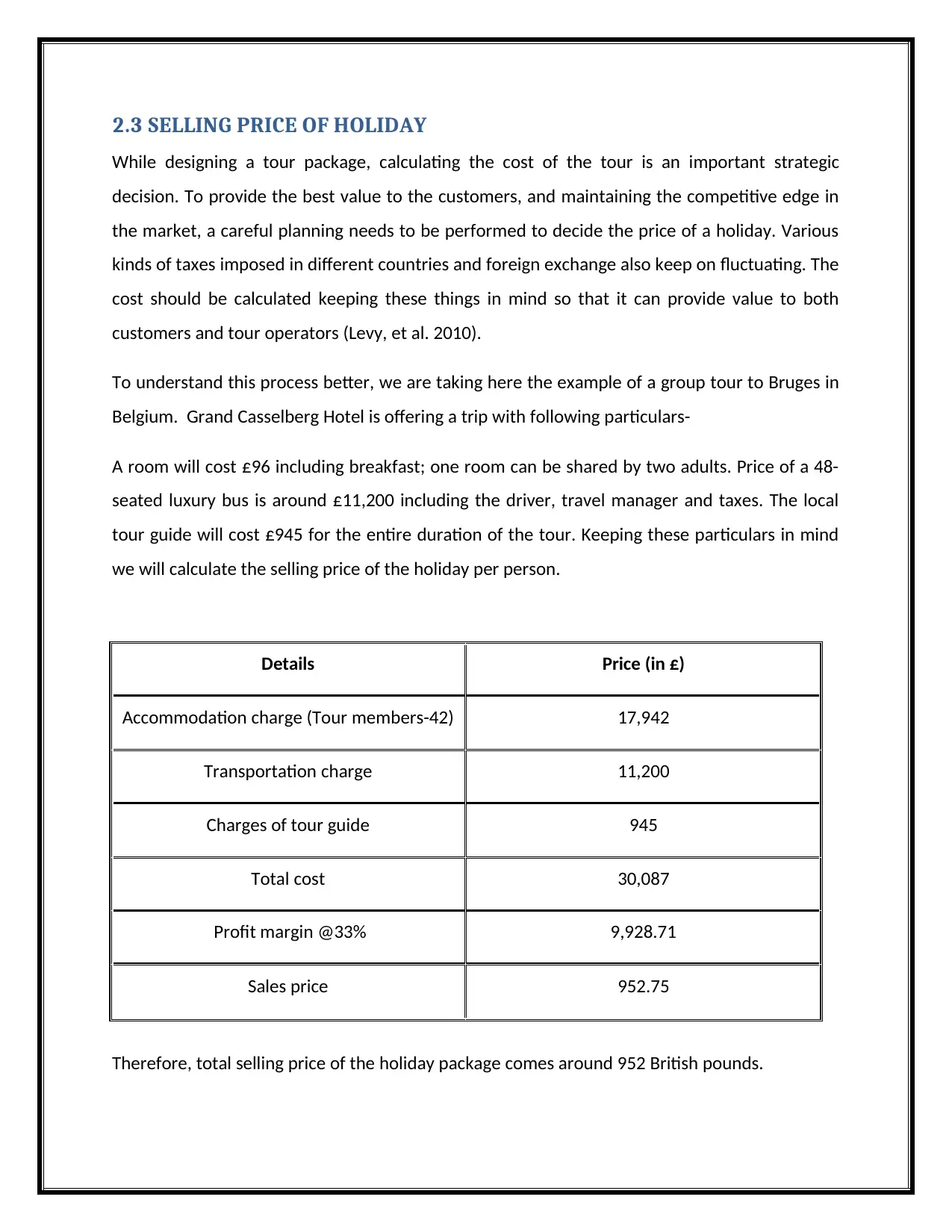
2.3 SELLING PRICE OF HOLIDAY
While designing a tour package, calculating the cost of the tour is an important strategic
decision. To provide the best value to the customers, and maintaining the competitive edge in
the market, a careful planning needs to be performed to decide the price of a holiday. Various
kinds of taxes imposed in different countries and foreign exchange also keep on fluctuating. The
cost should be calculated keeping these things in mind so that it can provide value to both
customers and tour operators (Levy, et al. 2010).
To understand this process better, we are taking here the example of a group tour to Bruges in
Belgium. Grand Casselberg Hotel is offering a trip with following particulars-
A room will cost £96 including breakfast; one room can be shared by two adults. Price of a 48-
seated luxury bus is around £11,200 including the driver, travel manager and taxes. The local
tour guide will cost £945 for the entire duration of the tour. Keeping these particulars in mind
we will calculate the selling price of the holiday per person.
Details Price (in £)
Accommodation charge (Tour members-42) 17,942
Transportation charge 11,200
Charges of tour guide 945
Total cost 30,087
Profit margin @33% 9,928.71
Sales price 952.75
Therefore, total selling price of the holiday package comes around 952 British pounds.
While designing a tour package, calculating the cost of the tour is an important strategic
decision. To provide the best value to the customers, and maintaining the competitive edge in
the market, a careful planning needs to be performed to decide the price of a holiday. Various
kinds of taxes imposed in different countries and foreign exchange also keep on fluctuating. The
cost should be calculated keeping these things in mind so that it can provide value to both
customers and tour operators (Levy, et al. 2010).
To understand this process better, we are taking here the example of a group tour to Bruges in
Belgium. Grand Casselberg Hotel is offering a trip with following particulars-
A room will cost £96 including breakfast; one room can be shared by two adults. Price of a 48-
seated luxury bus is around £11,200 including the driver, travel manager and taxes. The local
tour guide will cost £945 for the entire duration of the tour. Keeping these particulars in mind
we will calculate the selling price of the holiday per person.
Details Price (in £)
Accommodation charge (Tour members-42) 17,942
Transportation charge 11,200
Charges of tour guide 945
Total cost 30,087
Profit margin @33% 9,928.71
Sales price 952.75
Therefore, total selling price of the holiday package comes around 952 British pounds.
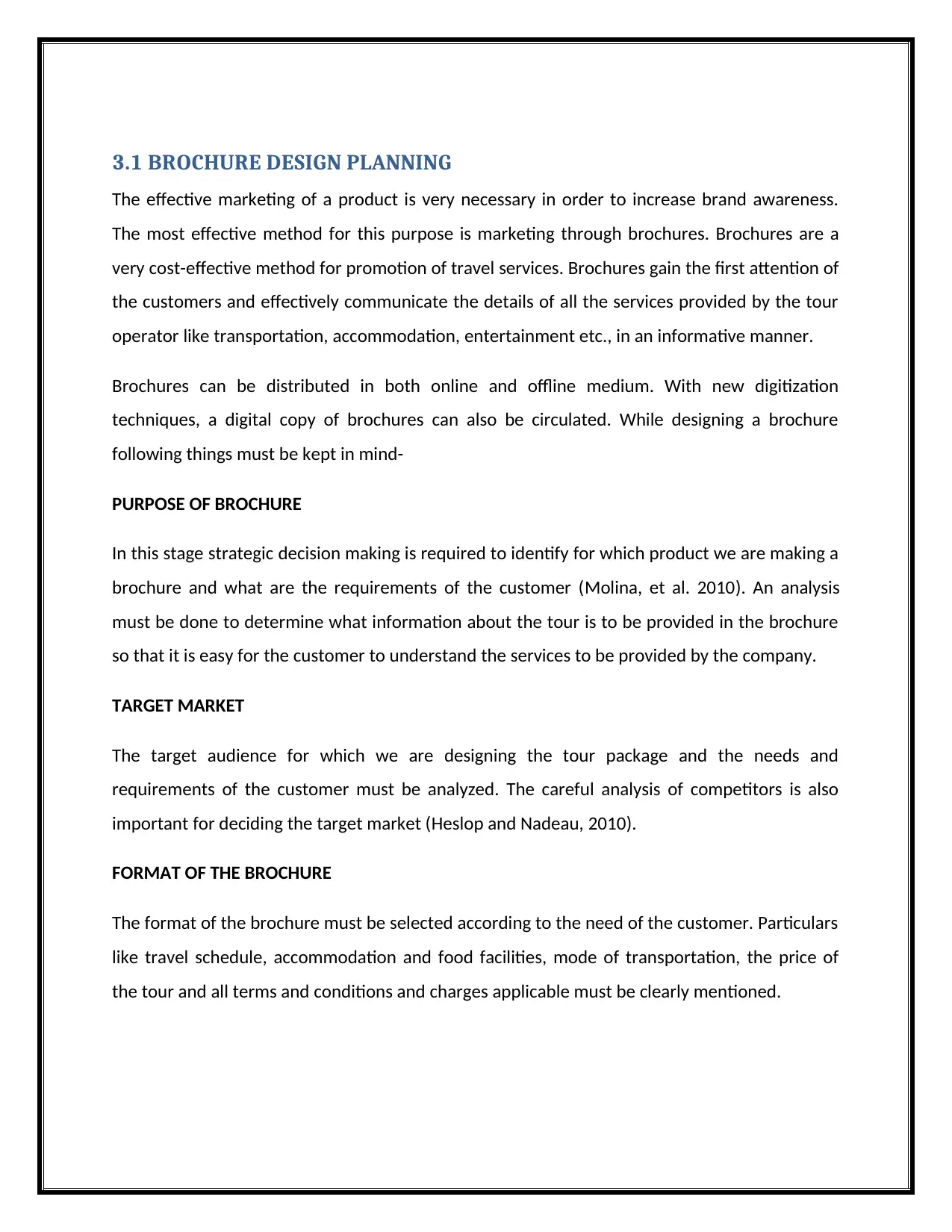
3.1 BROCHURE DESIGN PLANNING
The effective marketing of a product is very necessary in order to increase brand awareness.
The most effective method for this purpose is marketing through brochures. Brochures are a
very cost-effective method for promotion of travel services. Brochures gain the first attention of
the customers and effectively communicate the details of all the services provided by the tour
operator like transportation, accommodation, entertainment etc., in an informative manner.
Brochures can be distributed in both online and offline medium. With new digitization
techniques, a digital copy of brochures can also be circulated. While designing a brochure
following things must be kept in mind-
PURPOSE OF BROCHURE
In this stage strategic decision making is required to identify for which product we are making a
brochure and what are the requirements of the customer (Molina, et al. 2010). An analysis
must be done to determine what information about the tour is to be provided in the brochure
so that it is easy for the customer to understand the services to be provided by the company.
TARGET MARKET
The target audience for which we are designing the tour package and the needs and
requirements of the customer must be analyzed. The careful analysis of competitors is also
important for deciding the target market (Heslop and Nadeau, 2010).
FORMAT OF THE BROCHURE
The format of the brochure must be selected according to the need of the customer. Particulars
like travel schedule, accommodation and food facilities, mode of transportation, the price of
the tour and all terms and conditions and charges applicable must be clearly mentioned.
The effective marketing of a product is very necessary in order to increase brand awareness.
The most effective method for this purpose is marketing through brochures. Brochures are a
very cost-effective method for promotion of travel services. Brochures gain the first attention of
the customers and effectively communicate the details of all the services provided by the tour
operator like transportation, accommodation, entertainment etc., in an informative manner.
Brochures can be distributed in both online and offline medium. With new digitization
techniques, a digital copy of brochures can also be circulated. While designing a brochure
following things must be kept in mind-
PURPOSE OF BROCHURE
In this stage strategic decision making is required to identify for which product we are making a
brochure and what are the requirements of the customer (Molina, et al. 2010). An analysis
must be done to determine what information about the tour is to be provided in the brochure
so that it is easy for the customer to understand the services to be provided by the company.
TARGET MARKET
The target audience for which we are designing the tour package and the needs and
requirements of the customer must be analyzed. The careful analysis of competitors is also
important for deciding the target market (Heslop and Nadeau, 2010).
FORMAT OF THE BROCHURE
The format of the brochure must be selected according to the need of the customer. Particulars
like travel schedule, accommodation and food facilities, mode of transportation, the price of
the tour and all terms and conditions and charges applicable must be clearly mentioned.

STYLE, COLOR THEME AND QUALITY OF PAPER
The brochure design should be able to catch the attention of the customer at the same time
providing all the relevant information to the customer regarding mode of transport,
accommodation, tour guide etc.
The graphics and colours of the brochure must be selected to attract maximum attention of the
customer. The colour and graphics are a major attraction for the customer and it certainly
affects the decision making of the customer (Terestyenyi, 2011).
The quality of paper also plays an important role in customer decision making. Good quality
paper with nice texture must always be used to gain the attraction of customer. It also helps in
building a good brand image of the company.
The brochure design should be able to catch the attention of the customer at the same time
providing all the relevant information to the customer regarding mode of transport,
accommodation, tour guide etc.
The graphics and colours of the brochure must be selected to attract maximum attention of the
customer. The colour and graphics are a major attraction for the customer and it certainly
affects the decision making of the customer (Terestyenyi, 2011).
The quality of paper also plays an important role in customer decision making. Good quality
paper with nice texture must always be used to gain the attraction of customer. It also helps in
building a good brand image of the company.
Paraphrase This Document
Need a fresh take? Get an instant paraphrase of this document with our AI Paraphraser
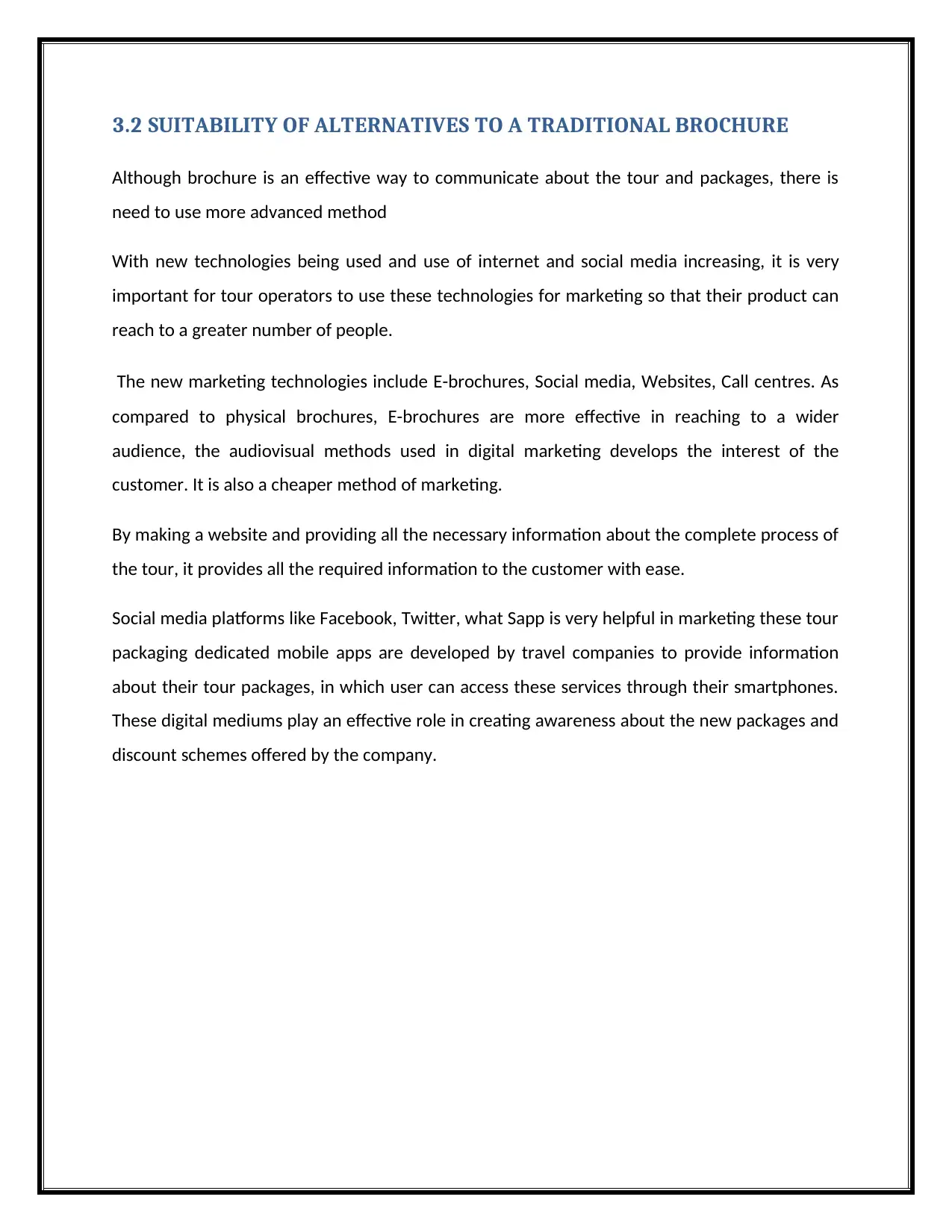
3.2 SUITABILITY OF ALTERNATIVES TO A TRADITIONAL BROCHURE
Although brochure is an effective way to communicate about the tour and packages, there is
need to use more advanced method
With new technologies being used and use of internet and social media increasing, it is very
important for tour operators to use these technologies for marketing so that their product can
reach to a greater number of people.
The new marketing technologies include E-brochures, Social media, Websites, Call centres. As
compared to physical brochures, E-brochures are more effective in reaching to a wider
audience, the audiovisual methods used in digital marketing develops the interest of the
customer. It is also a cheaper method of marketing.
By making a website and providing all the necessary information about the complete process of
the tour, it provides all the required information to the customer with ease.
Social media platforms like Facebook, Twitter, what Sapp is very helpful in marketing these tour
packaging dedicated mobile apps are developed by travel companies to provide information
about their tour packages, in which user can access these services through their smartphones.
These digital mediums play an effective role in creating awareness about the new packages and
discount schemes offered by the company.
Although brochure is an effective way to communicate about the tour and packages, there is
need to use more advanced method
With new technologies being used and use of internet and social media increasing, it is very
important for tour operators to use these technologies for marketing so that their product can
reach to a greater number of people.
The new marketing technologies include E-brochures, Social media, Websites, Call centres. As
compared to physical brochures, E-brochures are more effective in reaching to a wider
audience, the audiovisual methods used in digital marketing develops the interest of the
customer. It is also a cheaper method of marketing.
By making a website and providing all the necessary information about the complete process of
the tour, it provides all the required information to the customer with ease.
Social media platforms like Facebook, Twitter, what Sapp is very helpful in marketing these tour
packaging dedicated mobile apps are developed by travel companies to provide information
about their tour packages, in which user can access these services through their smartphones.
These digital mediums play an effective role in creating awareness about the new packages and
discount schemes offered by the company.
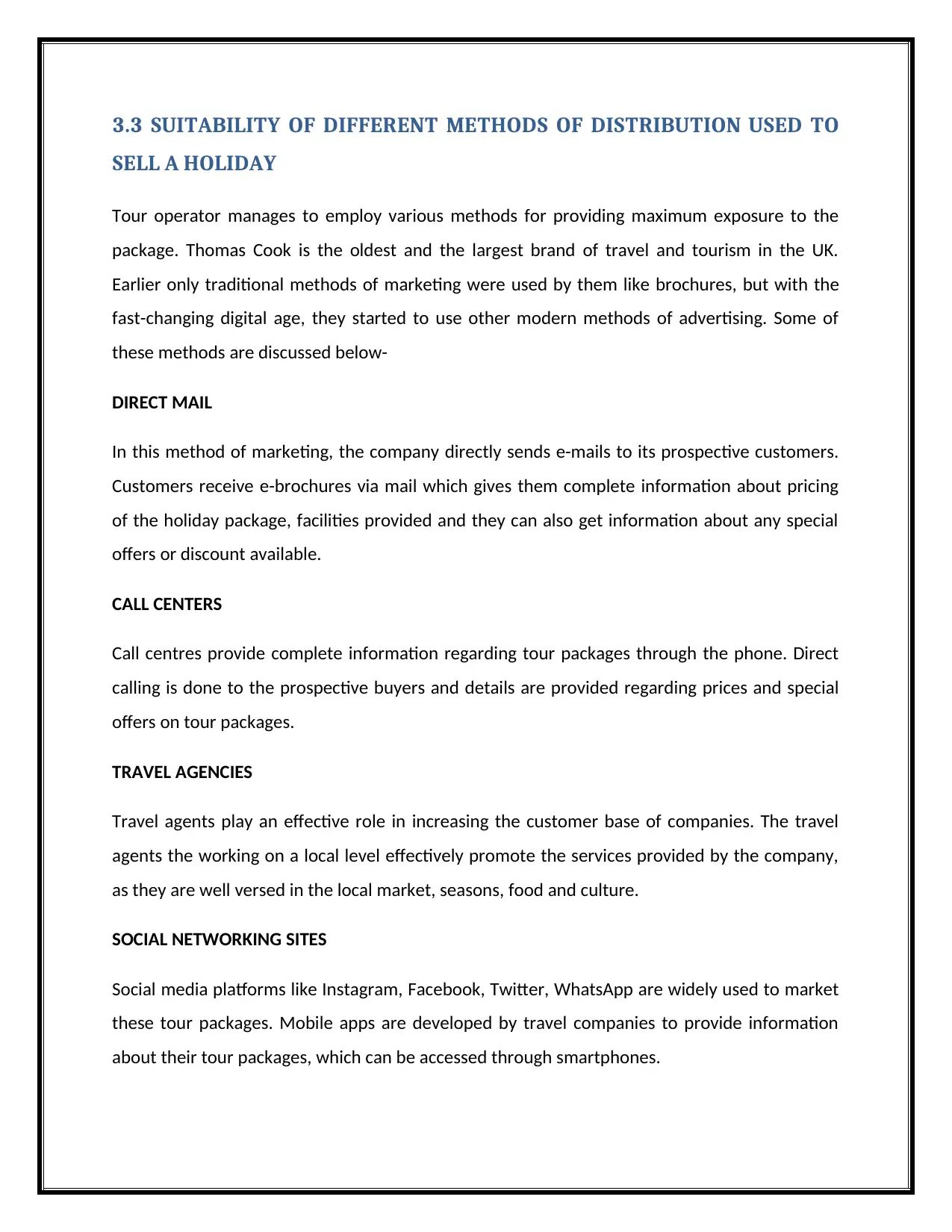
3.3 SUITABILITY OF DIFFERENT METHODS OF DISTRIBUTION USED TO
SELL A HOLIDAY
Tour operator manages to employ various methods for providing maximum exposure to the
package. Thomas Cook is the oldest and the largest brand of travel and tourism in the UK.
Earlier only traditional methods of marketing were used by them like brochures, but with the
fast-changing digital age, they started to use other modern methods of advertising. Some of
these methods are discussed below-
DIRECT MAIL
In this method of marketing, the company directly sends e-mails to its prospective customers.
Customers receive e-brochures via mail which gives them complete information about pricing
of the holiday package, facilities provided and they can also get information about any special
offers or discount available.
CALL CENTERS
Call centres provide complete information regarding tour packages through the phone. Direct
calling is done to the prospective buyers and details are provided regarding prices and special
offers on tour packages.
TRAVEL AGENCIES
Travel agents play an effective role in increasing the customer base of companies. The travel
agents the working on a local level effectively promote the services provided by the company,
as they are well versed in the local market, seasons, food and culture.
SOCIAL NETWORKING SITES
Social media platforms like Instagram, Facebook, Twitter, WhatsApp are widely used to market
these tour packages. Mobile apps are developed by travel companies to provide information
about their tour packages, which can be accessed through smartphones.
SELL A HOLIDAY
Tour operator manages to employ various methods for providing maximum exposure to the
package. Thomas Cook is the oldest and the largest brand of travel and tourism in the UK.
Earlier only traditional methods of marketing were used by them like brochures, but with the
fast-changing digital age, they started to use other modern methods of advertising. Some of
these methods are discussed below-
DIRECT MAIL
In this method of marketing, the company directly sends e-mails to its prospective customers.
Customers receive e-brochures via mail which gives them complete information about pricing
of the holiday package, facilities provided and they can also get information about any special
offers or discount available.
CALL CENTERS
Call centres provide complete information regarding tour packages through the phone. Direct
calling is done to the prospective buyers and details are provided regarding prices and special
offers on tour packages.
TRAVEL AGENCIES
Travel agents play an effective role in increasing the customer base of companies. The travel
agents the working on a local level effectively promote the services provided by the company,
as they are well versed in the local market, seasons, food and culture.
SOCIAL NETWORKING SITES
Social media platforms like Instagram, Facebook, Twitter, WhatsApp are widely used to market
these tour packages. Mobile apps are developed by travel companies to provide information
about their tour packages, which can be accessed through smartphones.
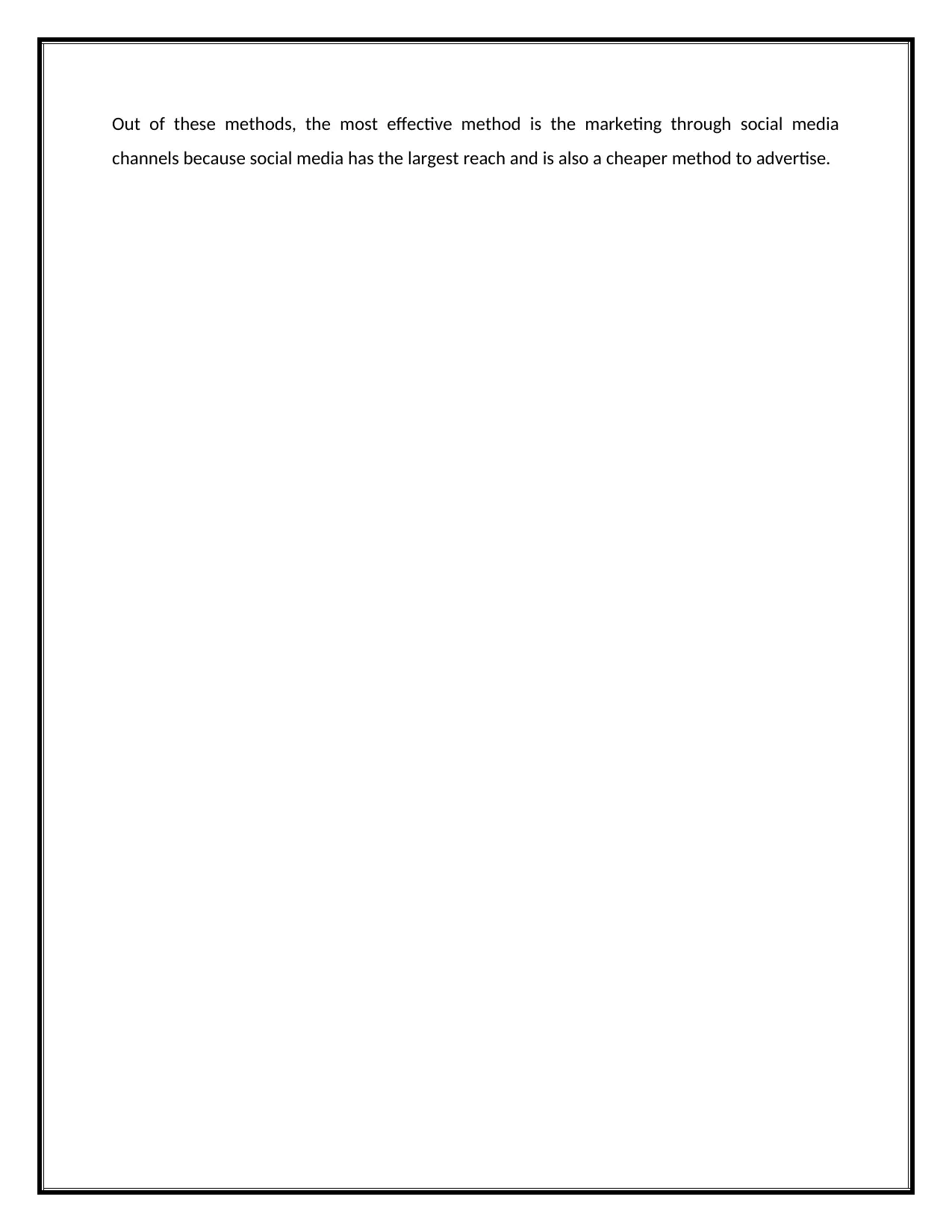
Out of these methods, the most effective method is the marketing through social media
channels because social media has the largest reach and is also a cheaper method to advertise.
channels because social media has the largest reach and is also a cheaper method to advertise.
Secure Best Marks with AI Grader
Need help grading? Try our AI Grader for instant feedback on your assignments.
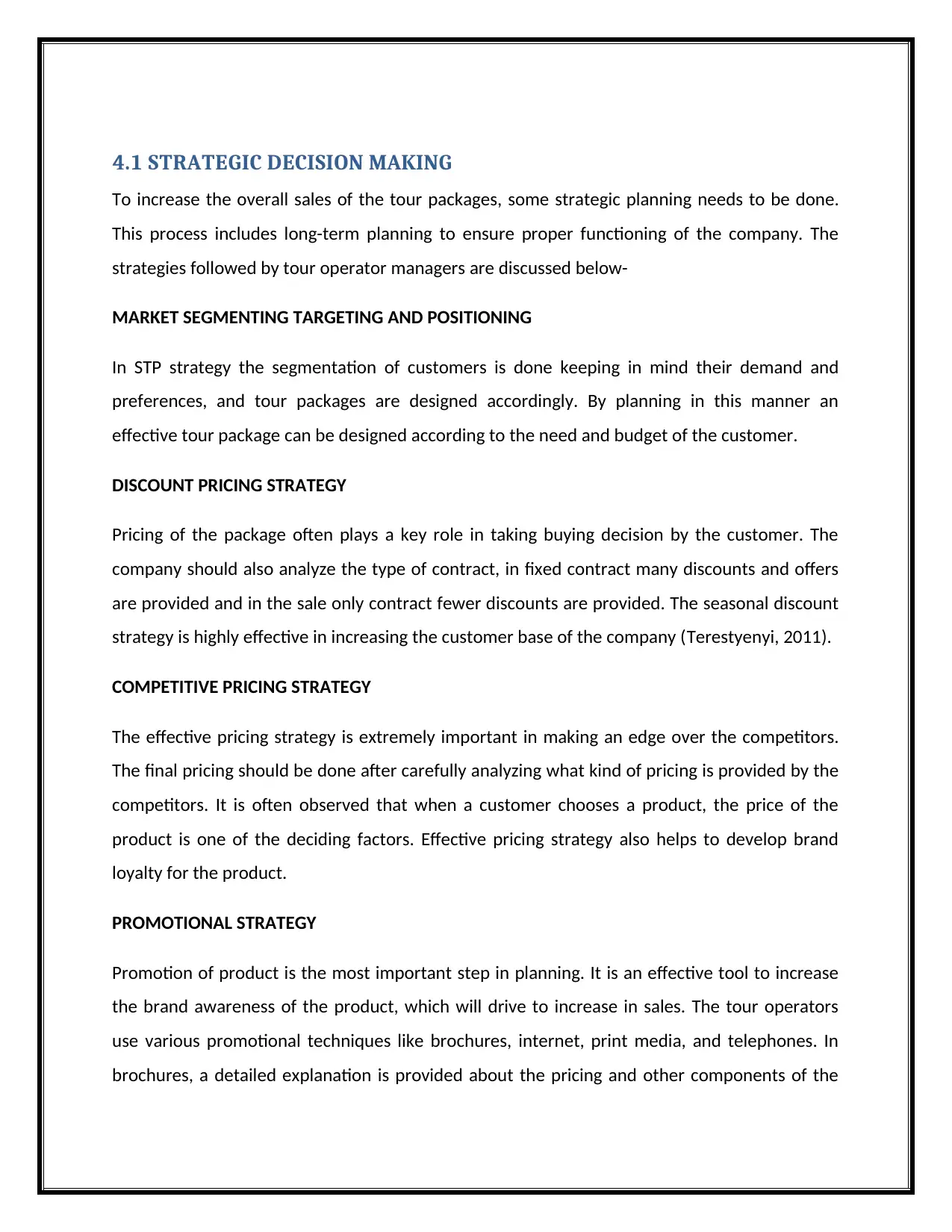
4.1 STRATEGIC DECISION MAKING
To increase the overall sales of the tour packages, some strategic planning needs to be done.
This process includes long-term planning to ensure proper functioning of the company. The
strategies followed by tour operator managers are discussed below-
MARKET SEGMENTING TARGETING AND POSITIONING
In STP strategy the segmentation of customers is done keeping in mind their demand and
preferences, and tour packages are designed accordingly. By planning in this manner an
effective tour package can be designed according to the need and budget of the customer.
DISCOUNT PRICING STRATEGY
Pricing of the package often plays a key role in taking buying decision by the customer. The
company should also analyze the type of contract, in fixed contract many discounts and offers
are provided and in the sale only contract fewer discounts are provided. The seasonal discount
strategy is highly effective in increasing the customer base of the company (Terestyenyi, 2011).
COMPETITIVE PRICING STRATEGY
The effective pricing strategy is extremely important in making an edge over the competitors.
The final pricing should be done after carefully analyzing what kind of pricing is provided by the
competitors. It is often observed that when a customer chooses a product, the price of the
product is one of the deciding factors. Effective pricing strategy also helps to develop brand
loyalty for the product.
PROMOTIONAL STRATEGY
Promotion of product is the most important step in planning. It is an effective tool to increase
the brand awareness of the product, which will drive to increase in sales. The tour operators
use various promotional techniques like brochures, internet, print media, and telephones. In
brochures, a detailed explanation is provided about the pricing and other components of the
To increase the overall sales of the tour packages, some strategic planning needs to be done.
This process includes long-term planning to ensure proper functioning of the company. The
strategies followed by tour operator managers are discussed below-
MARKET SEGMENTING TARGETING AND POSITIONING
In STP strategy the segmentation of customers is done keeping in mind their demand and
preferences, and tour packages are designed accordingly. By planning in this manner an
effective tour package can be designed according to the need and budget of the customer.
DISCOUNT PRICING STRATEGY
Pricing of the package often plays a key role in taking buying decision by the customer. The
company should also analyze the type of contract, in fixed contract many discounts and offers
are provided and in the sale only contract fewer discounts are provided. The seasonal discount
strategy is highly effective in increasing the customer base of the company (Terestyenyi, 2011).
COMPETITIVE PRICING STRATEGY
The effective pricing strategy is extremely important in making an edge over the competitors.
The final pricing should be done after carefully analyzing what kind of pricing is provided by the
competitors. It is often observed that when a customer chooses a product, the price of the
product is one of the deciding factors. Effective pricing strategy also helps to develop brand
loyalty for the product.
PROMOTIONAL STRATEGY
Promotion of product is the most important step in planning. It is an effective tool to increase
the brand awareness of the product, which will drive to increase in sales. The tour operators
use various promotional techniques like brochures, internet, print media, and telephones. In
brochures, a detailed explanation is provided about the pricing and other components of the
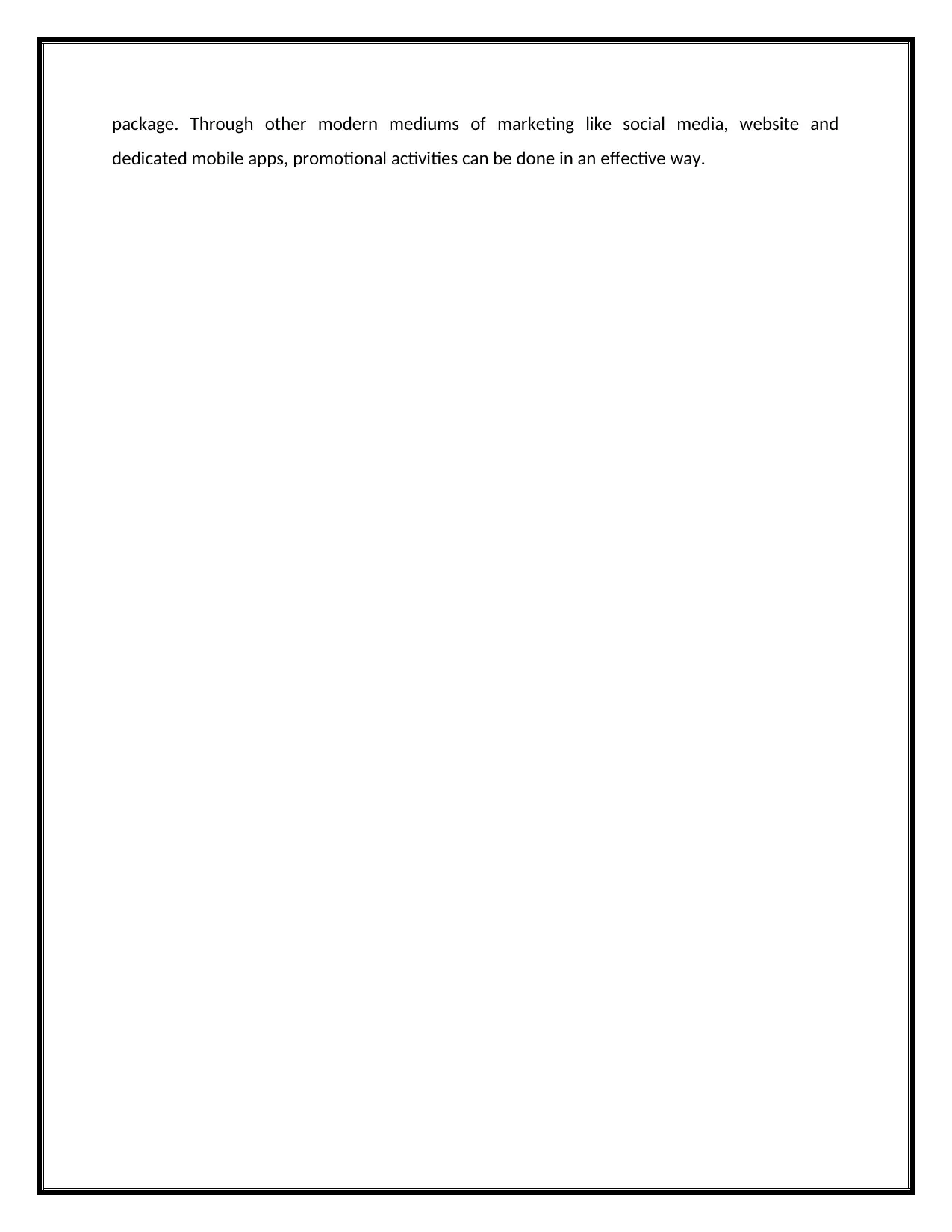
package. Through other modern mediums of marketing like social media, website and
dedicated mobile apps, promotional activities can be done in an effective way.
dedicated mobile apps, promotional activities can be done in an effective way.
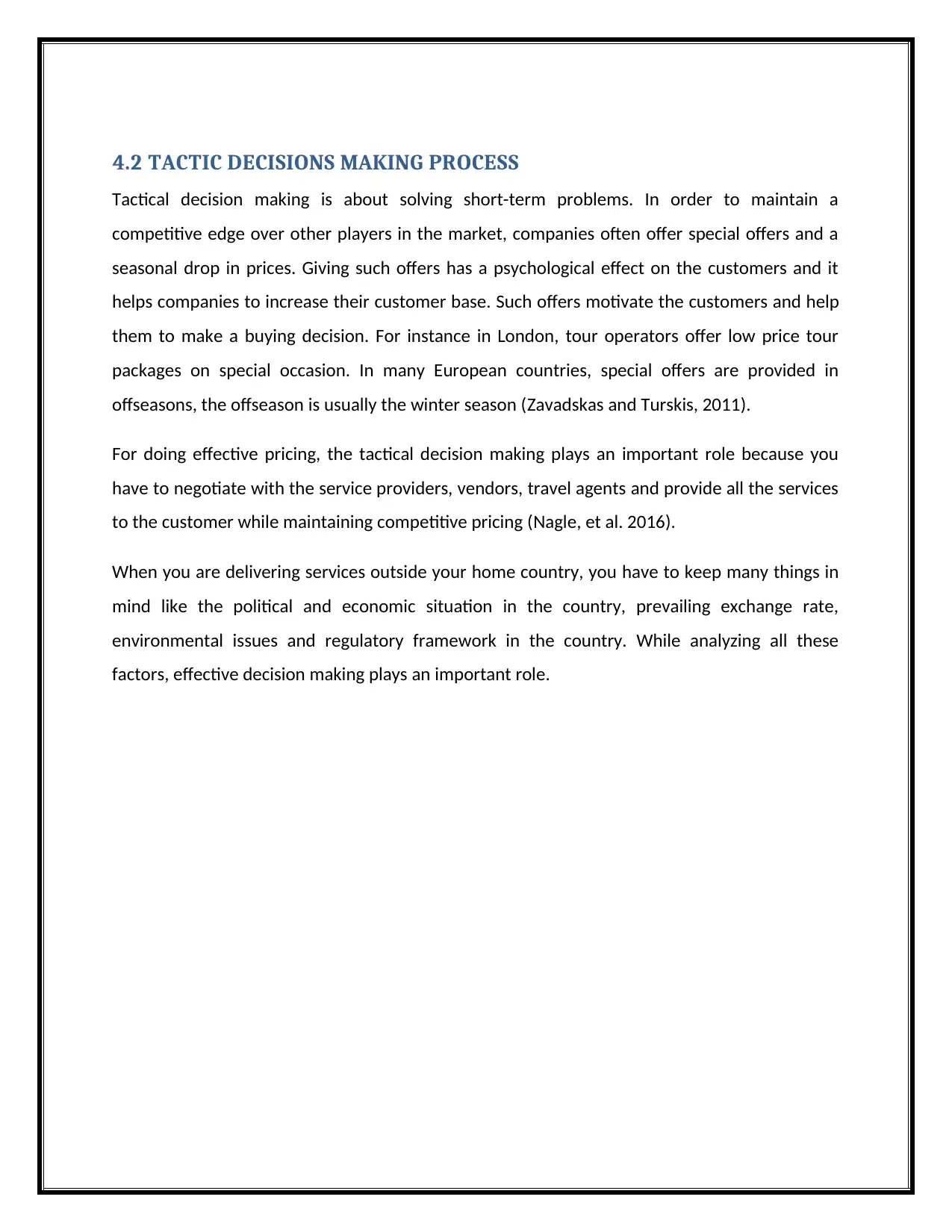
4.2 TACTIC DECISIONS MAKING PROCESS
Tactical decision making is about solving short-term problems. In order to maintain a
competitive edge over other players in the market, companies often offer special offers and a
seasonal drop in prices. Giving such offers has a psychological effect on the customers and it
helps companies to increase their customer base. Such offers motivate the customers and help
them to make a buying decision. For instance in London, tour operators offer low price tour
packages on special occasion. In many European countries, special offers are provided in
offseasons, the offseason is usually the winter season (Zavadskas and Turskis, 2011).
For doing effective pricing, the tactical decision making plays an important role because you
have to negotiate with the service providers, vendors, travel agents and provide all the services
to the customer while maintaining competitive pricing (Nagle, et al. 2016).
When you are delivering services outside your home country, you have to keep many things in
mind like the political and economic situation in the country, prevailing exchange rate,
environmental issues and regulatory framework in the country. While analyzing all these
factors, effective decision making plays an important role.
Tactical decision making is about solving short-term problems. In order to maintain a
competitive edge over other players in the market, companies often offer special offers and a
seasonal drop in prices. Giving such offers has a psychological effect on the customers and it
helps companies to increase their customer base. Such offers motivate the customers and help
them to make a buying decision. For instance in London, tour operators offer low price tour
packages on special occasion. In many European countries, special offers are provided in
offseasons, the offseason is usually the winter season (Zavadskas and Turskis, 2011).
For doing effective pricing, the tactical decision making plays an important role because you
have to negotiate with the service providers, vendors, travel agents and provide all the services
to the customer while maintaining competitive pricing (Nagle, et al. 2016).
When you are delivering services outside your home country, you have to keep many things in
mind like the political and economic situation in the country, prevailing exchange rate,
environmental issues and regulatory framework in the country. While analyzing all these
factors, effective decision making plays an important role.
Paraphrase This Document
Need a fresh take? Get an instant paraphrase of this document with our AI Paraphraser
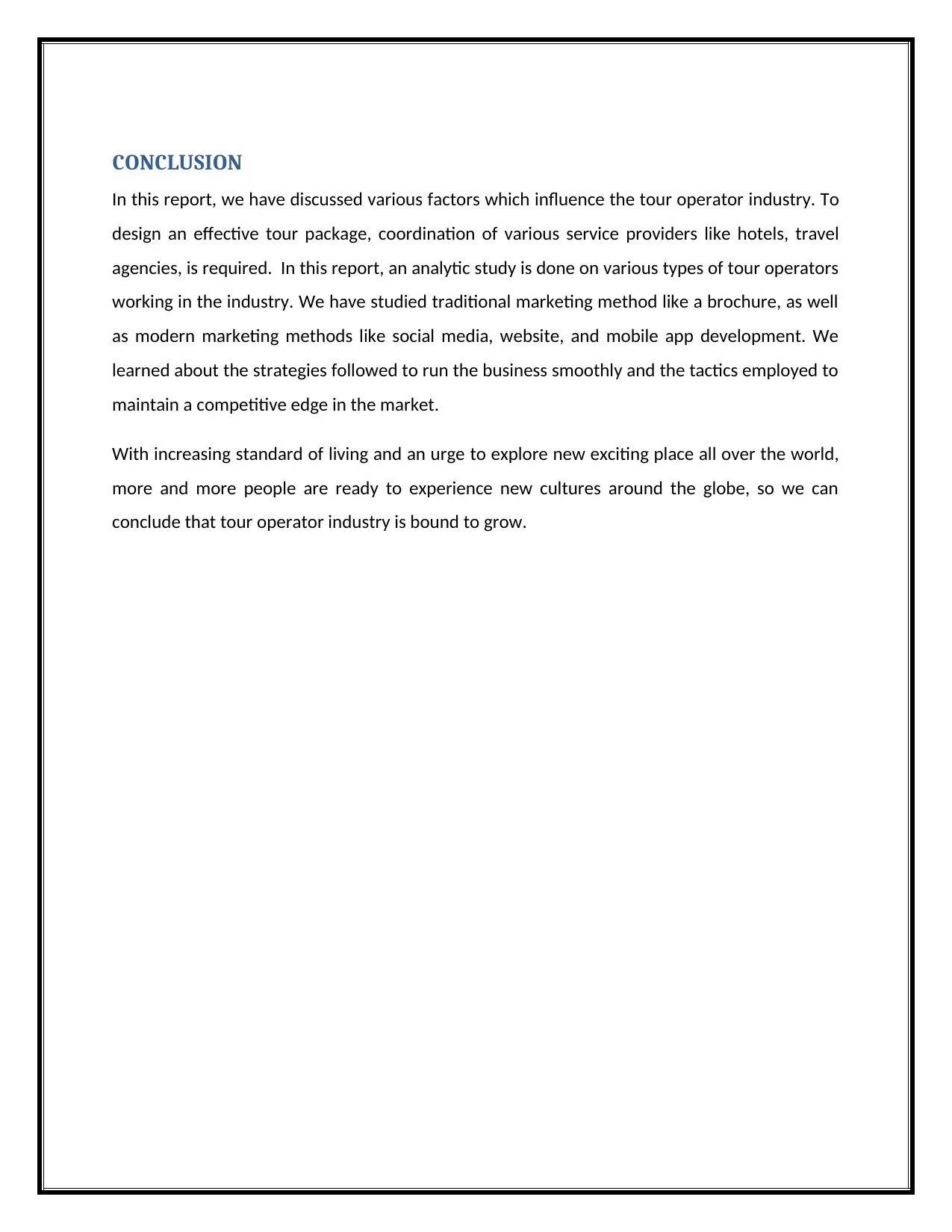
CONCLUSION
In this report, we have discussed various factors which influence the tour operator industry. To
design an effective tour package, coordination of various service providers like hotels, travel
agencies, is required. In this report, an analytic study is done on various types of tour operators
working in the industry. We have studied traditional marketing method like a brochure, as well
as modern marketing methods like social media, website, and mobile app development. We
learned about the strategies followed to run the business smoothly and the tactics employed to
maintain a competitive edge in the market.
With increasing standard of living and an urge to explore new exciting place all over the world,
more and more people are ready to experience new cultures around the globe, so we can
conclude that tour operator industry is bound to grow.
In this report, we have discussed various factors which influence the tour operator industry. To
design an effective tour package, coordination of various service providers like hotels, travel
agencies, is required. In this report, an analytic study is done on various types of tour operators
working in the industry. We have studied traditional marketing method like a brochure, as well
as modern marketing methods like social media, website, and mobile app development. We
learned about the strategies followed to run the business smoothly and the tactics employed to
maintain a competitive edge in the market.
With increasing standard of living and an urge to explore new exciting place all over the world,
more and more people are ready to experience new cultures around the globe, so we can
conclude that tour operator industry is bound to grow.
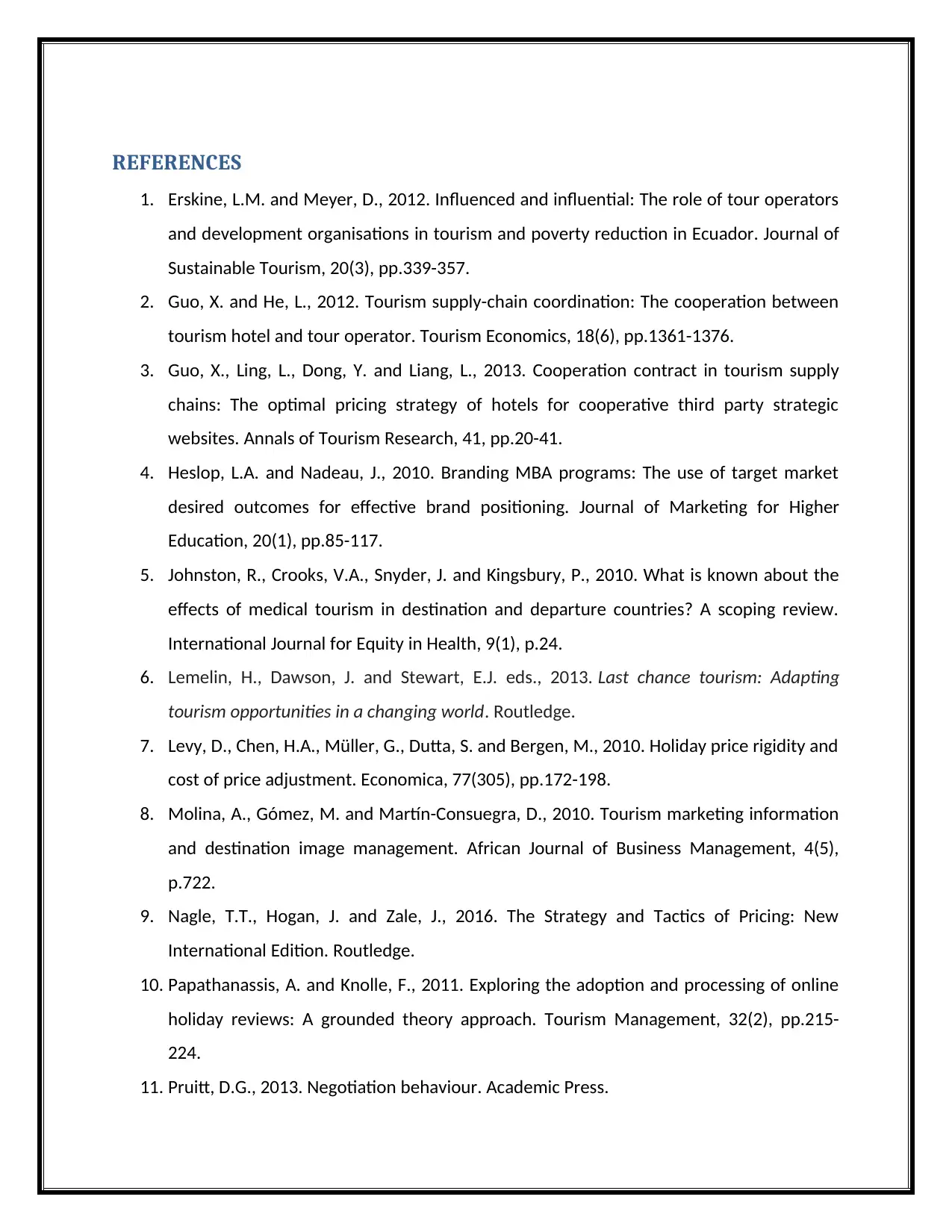
REFERENCES
1. Erskine, L.M. and Meyer, D., 2012. Influenced and influential: The role of tour operators
and development organisations in tourism and poverty reduction in Ecuador. Journal of
Sustainable Tourism, 20(3), pp.339-357.
2. Guo, X. and He, L., 2012. Tourism supply-chain coordination: The cooperation between
tourism hotel and tour operator. Tourism Economics, 18(6), pp.1361-1376.
3. Guo, X., Ling, L., Dong, Y. and Liang, L., 2013. Cooperation contract in tourism supply
chains: The optimal pricing strategy of hotels for cooperative third party strategic
websites. Annals of Tourism Research, 41, pp.20-41.
4. Heslop, L.A. and Nadeau, J., 2010. Branding MBA programs: The use of target market
desired outcomes for effective brand positioning. Journal of Marketing for Higher
Education, 20(1), pp.85-117.
5. Johnston, R., Crooks, V.A., Snyder, J. and Kingsbury, P., 2010. What is known about the
effects of medical tourism in destination and departure countries? A scoping review.
International Journal for Equity in Health, 9(1), p.24.
6. Lemelin, H., Dawson, J. and Stewart, E.J. eds., 2013. Last chance tourism: Adapting
tourism opportunities in a changing world. Routledge.
7. Levy, D., Chen, H.A., Müller, G., Dutta, S. and Bergen, M., 2010. Holiday price rigidity and
cost of price adjustment. Economica, 77(305), pp.172-198.
8. Molina, A., Gómez, M. and Martín-Consuegra, D., 2010. Tourism marketing information
and destination image management. African Journal of Business Management, 4(5),
p.722.
9. Nagle, T.T., Hogan, J. and Zale, J., 2016. The Strategy and Tactics of Pricing: New
International Edition. Routledge.
10. Papathanassis, A. and Knolle, F., 2011. Exploring the adoption and processing of online
holiday reviews: A grounded theory approach. Tourism Management, 32(2), pp.215-
224.
11. Pruitt, D.G., 2013. Negotiation behaviour. Academic Press.
1. Erskine, L.M. and Meyer, D., 2012. Influenced and influential: The role of tour operators
and development organisations in tourism and poverty reduction in Ecuador. Journal of
Sustainable Tourism, 20(3), pp.339-357.
2. Guo, X. and He, L., 2012. Tourism supply-chain coordination: The cooperation between
tourism hotel and tour operator. Tourism Economics, 18(6), pp.1361-1376.
3. Guo, X., Ling, L., Dong, Y. and Liang, L., 2013. Cooperation contract in tourism supply
chains: The optimal pricing strategy of hotels for cooperative third party strategic
websites. Annals of Tourism Research, 41, pp.20-41.
4. Heslop, L.A. and Nadeau, J., 2010. Branding MBA programs: The use of target market
desired outcomes for effective brand positioning. Journal of Marketing for Higher
Education, 20(1), pp.85-117.
5. Johnston, R., Crooks, V.A., Snyder, J. and Kingsbury, P., 2010. What is known about the
effects of medical tourism in destination and departure countries? A scoping review.
International Journal for Equity in Health, 9(1), p.24.
6. Lemelin, H., Dawson, J. and Stewart, E.J. eds., 2013. Last chance tourism: Adapting
tourism opportunities in a changing world. Routledge.
7. Levy, D., Chen, H.A., Müller, G., Dutta, S. and Bergen, M., 2010. Holiday price rigidity and
cost of price adjustment. Economica, 77(305), pp.172-198.
8. Molina, A., Gómez, M. and Martín-Consuegra, D., 2010. Tourism marketing information
and destination image management. African Journal of Business Management, 4(5),
p.722.
9. Nagle, T.T., Hogan, J. and Zale, J., 2016. The Strategy and Tactics of Pricing: New
International Edition. Routledge.
10. Papathanassis, A. and Knolle, F., 2011. Exploring the adoption and processing of online
holiday reviews: A grounded theory approach. Tourism Management, 32(2), pp.215-
224.
11. Pruitt, D.G., 2013. Negotiation behaviour. Academic Press.
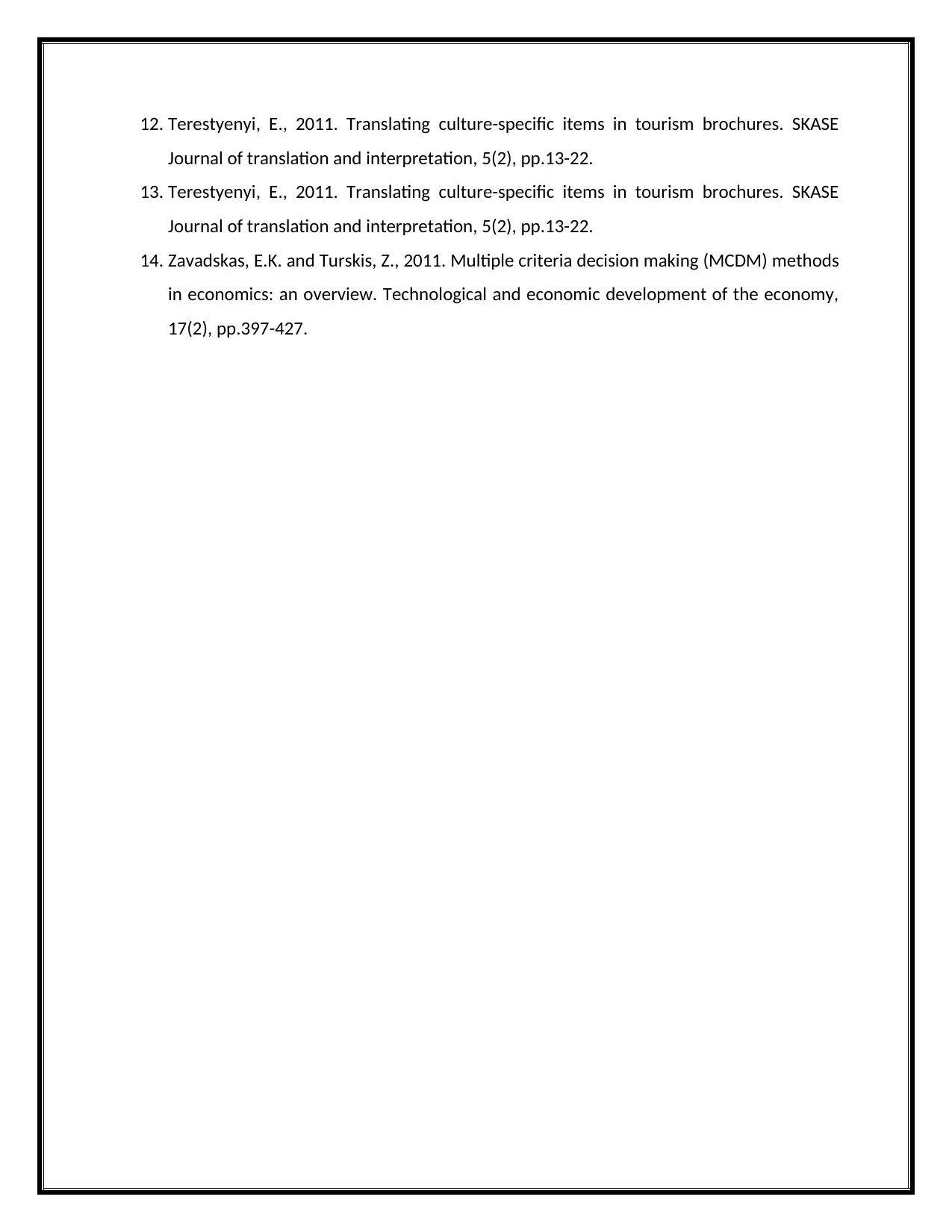
12. Terestyenyi, E., 2011. Translating culture-specific items in tourism brochures. SKASE
Journal of translation and interpretation, 5(2), pp.13-22.
13. Terestyenyi, E., 2011. Translating culture-specific items in tourism brochures. SKASE
Journal of translation and interpretation, 5(2), pp.13-22.
14. Zavadskas, E.K. and Turskis, Z., 2011. Multiple criteria decision making (MCDM) methods
in economics: an overview. Technological and economic development of the economy,
17(2), pp.397-427.
Journal of translation and interpretation, 5(2), pp.13-22.
13. Terestyenyi, E., 2011. Translating culture-specific items in tourism brochures. SKASE
Journal of translation and interpretation, 5(2), pp.13-22.
14. Zavadskas, E.K. and Turskis, Z., 2011. Multiple criteria decision making (MCDM) methods
in economics: an overview. Technological and economic development of the economy,
17(2), pp.397-427.
1 out of 22
Related Documents
Your All-in-One AI-Powered Toolkit for Academic Success.
+13062052269
info@desklib.com
Available 24*7 on WhatsApp / Email
![[object Object]](/_next/static/media/star-bottom.7253800d.svg)
Unlock your academic potential
© 2024 | Zucol Services PVT LTD | All rights reserved.





